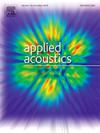Large eddy simulation for aeroacoustic prediction and characterization of electronics cooling axial fans under various operating conditions
IF 3.4
2区 物理与天体物理
Q1 ACOUSTICS
引用次数: 0
Abstract
This study provides a comprehensive investigation into the aerodynamic and aeroacoustic characteristics of a small-sized axial fan under various operating conditions, representing different system resistances in electronics cooling applications. A wall-resolved large eddy simulation (LES) approach, combined with the Ffowcs Williams-Hawkings (FW-H) acoustic analogy, is used to analyze the flow and noise characteristics for a realistic fan configuration. The numerical simulations are validated through comparison with experimental measurements, showing excellent agreement. The study reveals distinct flow and noise characteristics between normal and stall conditions of the fan. During normal operating conditions, paired inlet vortex tubes are observed due to the asymmetric inlet-rotor interaction. The flow structures near the blade tip, such as the inlet vortex tubes and tip vortices, exhibit higher coherence. However, during stall conditions, these structures become more disorganized. Additionally, laminar-turbulent separation and high leading-edge turbulence are observed during stall conditions, resulting in increased broadband noise level. Aeroacoustic analysis shows that tonal noise is more prominent during normal operating conditions, while broadband noise becomes more significant during stall conditions. The main tonal noise sources during normal conditions are the asymmetric inlet-rotor interaction and the rotor-stator interaction. On the other hand, the tip-gap noise serves as the primary source of broadband noise. During stall conditions, the leading-edge noise and flow separation noise become the main sources of broadband noise. The shroud noise significantly contributes to the tonal noise across all operating conditions. This study identifies the locations and dominant characteristics of the noise sources and analyzes the contributions of different noise sources to the overall fan noise.

求助全文
约1分钟内获得全文
求助全文
来源期刊

Applied Acoustics
物理-声学
CiteScore
7.40
自引率
11.80%
发文量
618
审稿时长
7.5 months
期刊介绍:
Since its launch in 1968, Applied Acoustics has been publishing high quality research papers providing state-of-the-art coverage of research findings for engineers and scientists involved in applications of acoustics in the widest sense.
Applied Acoustics looks not only at recent developments in the understanding of acoustics but also at ways of exploiting that understanding. The Journal aims to encourage the exchange of practical experience through publication and in so doing creates a fund of technological information that can be used for solving related problems. The presentation of information in graphical or tabular form is especially encouraged. If a report of a mathematical development is a necessary part of a paper it is important to ensure that it is there only as an integral part of a practical solution to a problem and is supported by data. Applied Acoustics encourages the exchange of practical experience in the following ways: • Complete Papers • Short Technical Notes • Review Articles; and thereby provides a wealth of technological information that can be used to solve related problems.
Manuscripts that address all fields of applications of acoustics ranging from medicine and NDT to the environment and buildings are welcome.
 求助内容:
求助内容: 应助结果提醒方式:
应助结果提醒方式:


